UWE-1 (Universität Würzburg's Experimentalsatellit-1)
Non-EO
Quick facts
Overview
| Mission type | Non-EO |
| Launch date | 27 Oct 2005 |
| End of life date | Jan 2006 |
UWE-1 (Universität Würzburg's Experimentalsatellit-1)
UWE is a picosatellite technology project within the CubeSat family standard, developed and built by students of the University of Würzburg and Fachhochschule Weingarten, Germany. The intent is always to enrich the student training program, to stimulate interest in a problem-solving multi-disciplinary technical environment, to be imaginative and resourceful, and to take some risks – with ample and essential help from mentors and partners (industry, institutional, or otherwise).
The overall project objective is to test adaptations of Internet protocols [such as: TCP (Transmission Control Protocol), UDP (User Datagram Protocol), STCP (Stream Control Transmission Protocol), HTTP (HyperText Transfer Protocol)] to the space environment, characterized by significant signal propagation delays due to the large distances and much higher noise levels compared to terrestrial links. 1) 2) 3) 4) 5) 6) 7) 8) 9)
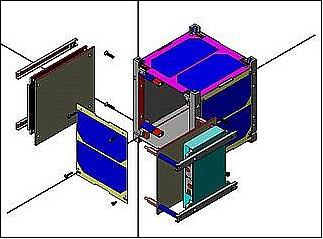
Spacecraft
UWE-1 is a CubeSat of size 10 cm x 10 cm x 10 cm with a mass of = ≤ 1.0 kg, designed and developed by an international team of students. The structural design of the satellite satisfies the CubeSat requirements with regard to size, mass and strength (launch phase). The picosatellite is comprised of the subsystems: onboard data handling, communication, power, orbit and attitude control, structure, and thermal. The attitude of the satellite is passively controlled by means of permanent magnets (in two axis). The axis of “no magnet control” is selected as the spin axis of the satellite. The power subsystem uses surface-mounted solar cells (triple-junction GaAs cells) providing an average power of 2 W, sufficient for spacecraft operations and battery recharging (use of 2 Li-ion batteries, each with a capacity of 2300 mAh).
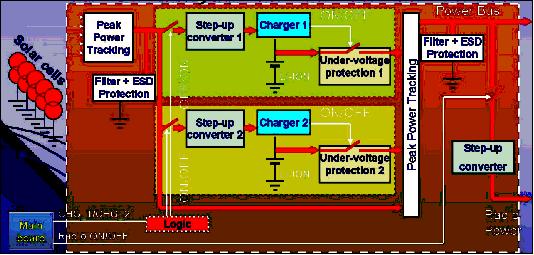
A micro Linux operating system (µCLinux) is implemented in a low-power H8S-2674R microprocessor (Hitachi) to provide the capability of testing the communication protocols and to increase the potential for applications, such as ftp-server, http-server, or mission-specific applications. The onboard software can be upgraded and modified to suit the operational requirements of the application on the spaceborne platform. The onboard communication between the Linux operating system and the transceiver utilizes the 6Pack protocol.
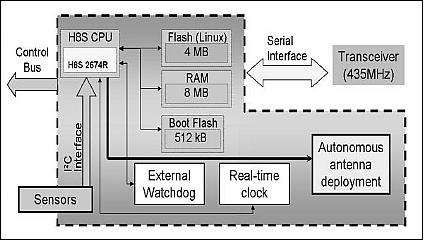
The OBDH subsystem is built around the 16 bit H8S 2674 microprocessor. Under normal conditions, the complete OBDH system requires typically less than 300 mW, a significant benefit of this architecture. Several interfaces connect the main processor to the various on–board components. A connection to the power bus supplies the board with energy, a control bus to the power board offers the possibility to implement in software an efficient power management based on sensor information, one I2C interface is used to read data from the onboard sensors, and an RS-232 interface to the transceiver is used to send and receive data from the ground station.
RF communications: A modified off-the-shelf transceiver (1 W transmit power) is being used to communicate with the ground station in the radio-amateur band (UHF, VHF) using the AX-25 protocol (assigned downlink frequency of 437.505 MHz). The transmission rate and modulation can be modified by command, to either a 9600 baud FSK or to a 1200 baud AFSK-modulated signal. The ground station for UWE-1 (at the University of Würzburg) has the capability of sending and receiving on the amateur radio band. UWE-1 provides services like ftp or a web server. These services can be accessed directly from the Internet due to the configuration of the ground station as a gateway between the Internet and the satellite. All applications running onboard UWE-1 can also be accessed via the Internet.
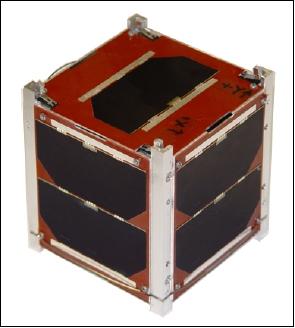
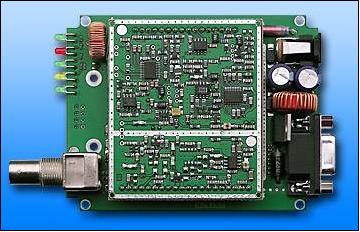
Launch
A launch of UWE-1 as a secondary payload took place on Oct. 27, 2005 on a Cosmos-3M launch vehicle from the Plesetsk Cosmodrome, Russia. The primary payloads on this flight are: China DMC+4 (Beijing-1) and TopSat of SSTL, UK. The other secondary payloads on this multi-satellite flight are: SSETI Express (European Students), Mozhayets 5 (Russia), Sinah-1 (Iran), CubeSat XI-V (University of Tokyo), NCube-2 (Norwegian CubeSat-2), Norway, and Rubin-5 (OHB, Bremen, Germany).
CubeSat deployment. The three CubeSat passengers (i.e., picosatellites) of SSETI Express are: UWE-1 (Universität Würzburg Experimentalsatellit-1), Würzburg, Germany; XI-V (X-factor Investigator-V) of the University of Tokyo, Tokyo, Japan; and NCube-2 (Norwegian CubeSat-2) from Norway. The deployment of the CubeSats employs T-POD (Tokyo-Picosatellite Orbital Deployer), provided jointly by Japan (University of Tokyo) and Canada (University of Toronto); one T-POD is being used for each CubeSat.
Note: T-POD was already developed and used to eject the XI-IV CubeSat from the Rockot launch vehicle in a multiple CubeSat launch (6 picosatellites) on June 30, 2003 from Plesetsk, Russia. The T-POD development is not regarded as a competition to P-POD (Poly-Picosatellite Orbital Deployer) of CalPoly; rather, it is considered a complementary element in case of need being offered by a potential launch opportunity.

The 3 CubeSats were deployed successfully from SSETI Express 64 minutes into the mission and so far signals from XI-V and UWE-1 have been successfully received at their respective ground stations. 10)
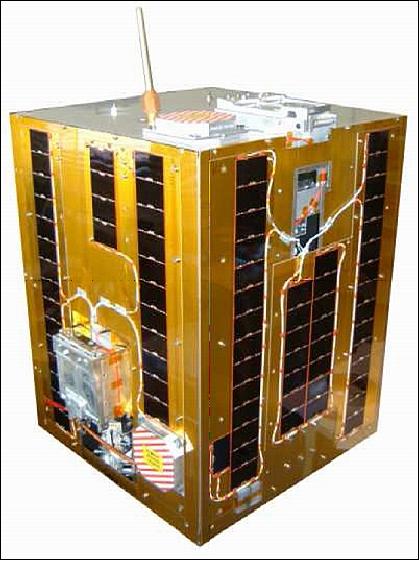
Orbit: Sun-synchronous circular orbit, altitude = 686 km, inclination = 98.2º.
Sensor Complement
The main mission objective of UWE-1 is to analyze and optimize different implementations of Internet protocols in space, taking into account typical characteristics of the radio link regarding delays, noise, interruptions, low bandwidth and high packet loss rates. The complete payload is implemented in software and a comparison basis for performance measurements had to be established.
Since the µCLinux operating system employs the standard TCP/IP protocol stack by default, this is being used as a comparison basis for performance measurements of the various protocol experiments.

Mission Status
The UWE-1 CubeSat completed its mission successfully after the first few weeks in orbit.
• Directly after deployment, regular operations could be initiated after a very short start up phase. After most experiments had been completed, contact with UWE-1 had been lost in January 2006 and could not be reestablished despite many attempts.
• Several technology tests were performed on UWE-1 with regard to the solar cells, the µCLinux operating system, the validation of the passive attitude control, and the verification of the thermal design.
• The UWE-1 mission completed the planned telecommunication experiments on Internet protocols \[one of the most important characteristics determined in the experimental phase is the BER (Bit Error Rate) in the downlink\] and the technology tests, in particular the in-orbit characterization of new GaAs solar cells.
On the educational side, UWE-1 was perceived by the students as a very motivating hands-on example to apply satellite system design techniques. For future designs of UWE picosatellites, additional emphasis will be placed in the redundancy of the on-board data handling system as well as in the ground segment for early post-launch operations. These aspects are now being implemented in the picosatellite UWE-2 (2006). The objective is to continue the communication protocol experiments and to include technology tests related to attitude determination.
Referencing
1) R. Barza, Y. Aoki, K. Schilling, “UWE-1, A Student Built Pico-Satellite,” REM-2005 (6th International Workshop on Research and Education in Mechatronics), June 30-July 1, 2005, Annecy, France
2) K. Schilling, “CubeSats Students Design and Realize Pico-Satellites,” Space Technology Education Conference (STEC), April 14-16, 2004, Lausanne, Switzerland, http://space2.epfl.ch/downloads/Schilling.pdf
3) http://www7.informatik.uni-wuerzburg.de/cubesat/
4) Y. Aoki, R. Radu, F. Zeiger, B. Herbst, K. Schilling, “The CubeSat Project at the University of Würzburg: The Mission and System Design,” STEC 2005, April 6-8, 2005, Aalborg University, Aalborg, Denmark
5) B. Herbst, F. Zeiger, M. Schmidt, K. Schilling, “UWE-1: A Picosatellite to Test Communication Protocols,” Proceedings of the 56th IAC 2005, Fukuoda, Japan, Oct. 17-21, 2005, IAC-05-B5.6.A.11
6) R. Barza, Y. Aoki, K. Schilling, “CubeSat UWE-1 - Technology Test and in orbit Results,” Proceedings of the 57th IAC/IAF/IAA (International Astronautical Congress), Valencia, Spain, Oct. 2-6, 2006, IAC-06-B5.3.07
7) K. Schilling, M. Schmidt, R. Barza, “In orbit experiences from the picosatellite UWE-1,” Proceedings of the 4S Symposium: `Small Satellite Systems and Services,' Chia Laguna Sardinia, Italy, Sept. 25-29, 2006, ESA SP-618
8) M. Schmidt, “Design and Implementation of In-Orbit Experiments for the Pico Satellite UWE-1,” Proceedings of the 57th IAC/IAF/IAA (International Astronautical Congress), Valencia, Spain, Oct. 2-6, 2006, IAC-06-E2.1.7
9) F. Zeiger, M. Schmidt, K. Schilling, “A Flexible Extension for Pico-Satellite Communication Based On Orbit Operation Results of UWE-1,” Proceedings of the 57th IAC/IAF/IAA (International Astronautical Congress), Valencia, Spain, Oct. 2-6, 2006, IAC-06-B5.2.5
10) http://www.esa.int/SPECIALS/sseti_express/SEMCMZ538FE_0.html
The information compiled and edited in this article was provided by Herbert J. Kramer from his documentation of: "Observation of the Earth and Its Environment: Survey of Missions and Sensors" (Springer Verlag) as well as many other sources after the publication of the 4th edition in 2002. - Comments and corrections to this article are always welcome for further updates.